Diagnostic Performance of a Molecular Assay in Synovial Fluid Targeting Dominant Prosthetic Joint Infection Pathogens
Abstract
:1. Introduction
2. Materials and Methods
2.1. Patients and Samples
2.2. Genomic DNA Extraction from Reference Strains and SF Samples
2.3. Identification of Microorganisms Isolated from SF
2.4. Inflammation Marker Analysis
2.5. Bacterial and Fungal Pathogen-Specific Primer and Probe Design
2.6. qPCR Hydrolysis Probes Assay
2.7. Determination of the Limit of Detection (LOD)
2.8. 16S rRNA and ITS Sequencing Using DreamDX and Universal Primers
2.9. Analysis of the Specificity of the PJI Molecular Diagnostic Assay
2.10. Statistical Analysis
3. Results
3.1. Patients and Clinical Samples
3.2. Bacterial Culture Results and Prevalence of Bacterial Pathogens in SF Samples
3.3. LOD of the qPCR Hydrolysis Probes Assay for PJI Diagnosis
3.4. Specificity of the qPCR Hydrolysis Probe Assay for PJI Diagnosis
3.5. Clinical Utility of the qPCR Hydrolysis Probe Assay for the Detection of Bacterial Pathogens Causing PJIs in Uncultured SF
3.6. Comparison of Host Inflammation Marker Levels between Culture and Molecular Diagnostic Assay-Positive and -Negative Groups
4. Discussion
5. Patents
Supplementary Materials
Author Contributions
Funding
Data Availability Statement
Conflicts of Interest
References
- Li, C.; Ojeda-Thies, C.; Xu, C.; Trampuz, A. Meta-Analysis in Periprosthetic Joint Infection: A Global Bibliometric Analysis. J. Orthop. Surg. Res. 2020, 15, 251. [Google Scholar] [CrossRef]
- Izakovicova, P.; Borens, O.; Trampuz, A. Periprosthetic Joint Infection: Current Concepts and Outlook. EFORT Open Rev. 2019, 4, 482–494. [Google Scholar] [CrossRef]
- Kim, H.S.; Park, J.W.; Moon, S.Y.; Lee, Y.K.; Ha, Y.C.; Koo, K.H. Current and Future Burden of Periprosthetic Joint Infection from National Claim Database. J. Korean Med. Sci. 2020, 21, e410. [Google Scholar] [CrossRef]
- Ko, M.S.; Choi, C.H.; Yoon, H.K.; Yoo, J.H.; Oh, H.C.; Lee, J.H.; Park, S.H. Risk Factors of Postoperative Complications Following Total Knee Arthroplasty in Korea. Medicine 2021, 100, e28052. [Google Scholar] [CrossRef]
- Tande, A.J.; Patel, R. Prosthetic Joint Infection. Clin. Microbiol. Rev. 2014, 27, 302–345. [Google Scholar] [CrossRef]
- Takeuchi, R.; Umemoto, Y.; Aratake, M.; Bito, H.; Saito, I.; Kumagai, K.; Sasaki, Y.; Akamatsu, Y.; Ishikawa, H.; Koshino, T.; et al. A Mid Term Comparison of Open Wedge High Tibial Osteotomy vs. Unicompartmental Knee Arthroplasty for Medial Compartment Osteoarthritis of the Knee. J. Orthop. Surg. Res. 2010, 5, 65. [Google Scholar] [CrossRef]
- Fu, D.; Li, G.; Chen, K.; Zhao, Y.; Hua, Y.; Cai, Z. Comparison of High Tibial Osteotomy and Unicompartmental Knee Arthroplasty in the Treatment of Unicompartmental Osteoarthritis A Meta-Analysis. J. Arthroplast. 2013, 28, 759–765. [Google Scholar] [CrossRef]
- Ivy, M.I.; Thoendel, M.J.; Jeraldo, P.R.; Greenwood-Quaintance, K.E.; Hanssen, A.D.; Abdel, M.P.; Chia, N.; Yao, J.Z.; Tande, A.J.; Mandrekar, J.N.; et al. Direct Detection and Identification of Prosthetic Joint Infection Pathogens in Synovial Fluid by Metagenomic Shotgun Sequencing. J. Clin. Microbiol. 2018, 56, e00402-18. [Google Scholar] [CrossRef]
- Parcizi, J.; Tan, T.; Goswami, K.; Higuera, C.; Della Valle, C.; Chen, A.F.; Shohat, N. The 2018 Definition of Periprosthetic Hip and Knee Infection: An Evidence-Based and Validated Criteria. J. Arthroplast. 2018, 33, 1309–1314. [Google Scholar] [CrossRef]
- Chen, Y.; Kang, X.; Tao, J.; Zhang, Y.; Chenting, Y.; Lin, W. Reliability of Synovial Fluid Alpha-Defensin and Leukocyte Esterase in Diagnosing Periprosthetic Joint Infection (PJI): A Systematic Review and Meta-Analysis. J. Orthop. Surg. Res. 2019, 14, 453. [Google Scholar] [CrossRef]
- Zimmerli, W. Clinical Presentation and Treatment of Orthopaedic Implant-Associated Infection. J. Intern. Med. 2014, 276, 111–119. [Google Scholar] [CrossRef]
- Barrett, L.; Atkins, B. The Clinical Presentation of Prosthetic Joint Infection. J. Antimicrob. Chemother. 2014, 69 (Suppl. S1), i25–i27. [Google Scholar] [CrossRef]
- Triffault-Fillit, C.; Ferry, T.; Laurent, F.; Pradat, P.; Dupieux, C.; Conrad, A.; Becker, A.; Lustig, S.; Fessy, M.H.; Chidiac, C.; et al. Microbiologic Epidemiology Depending on Time to Occurrence of Prosthetic Joint Infection: A Prospective Cohort Study. Clin. Microbiol. Infect. 2019, 35, 353–358. [Google Scholar] [CrossRef]
- Rakow, A.; Perka, C.; Trampuz, A.; Renz, N. Origin and Characteristics of Haematogenous Periprosthetic Joint Infection. Clin. Microbiol. Infect. 2019, 25, 845–850. [Google Scholar] [CrossRef]
- Schulz, P.; Dlaska, C.E.; Perka, C.; Trampuz, A.; Renz, N. Preoperative Synovial Fluid Culture Poorly Predicts the Pathogen Causing Periprosthetic Joint Infection. Infection 2021, 49, 427–436. [Google Scholar] [CrossRef]
- Chisari, E.; Lin, F.; Fei, J.; Parvizi, J. Fungal Periprosthetic Joint Infection: Rare but Challenging Problem. Chin. J. Traumatol. 2022, 25, 63–66. [Google Scholar] [CrossRef]
- Gross, C.E.; Della Valle, C.J.; Rex, J.C.; Traven, S.A.; Durante, E.C. Fungal Periprosthetic Joint Infection: A Review of Demographics and Management. J. Arthroplast. 2021, 36, 1758–1764. [Google Scholar] [CrossRef]
- Sambri, A.; Zunarelli, R.; Fiore, M.; Bortoli, M.; Paolucci, A.; Filippini, M.; Zamparini, E.; Tedeschi, S.; Viale, P.; De Paolis, M. Epidemiology of Fungal Periprosthetic Joint Infection: A Systematic Review of the Literature. Microorganisms 2022, 11, 84. [Google Scholar] [CrossRef]
- Randau, T.M.; Molitor, E.; Fröschen, F.S.; Hörauf, A.; Kohlhof, H.; Scheidt, S.; Gravius, S.; Hischebeth, G.T. The Performance of a Dithiothreitol-Based Diagnostic System in Diagnosing Periprosthetic Joint Infection Compared to Sonication Fluid Cultures and Tissue Biopsies. Z. Orthop. Unfall. 2021, 159, 447–453. [Google Scholar] [CrossRef]
- Bonanzinga, T.; Zahar, A.; Dütsch, M.; Lausmann, C.; Kendoff, D.; Gehrke, T. How Reliable Is the Alpha-Defensin Immunoassay Test for Diagnosing Periprosthetic Joint Infection? A Prospective Study. Clin. Orthop. Relat. Res. 2017, 475, 408–415. [Google Scholar] [CrossRef]
- Gallo, J.; Kolar, M.; Dendis, M.; Loveckova, Y.; Sauer, P.; Zapletalova, J.; Koukalova, D. Culture and PCR Analysis of Joint Fluid in the Diagnosis of Prosthetic Joint Infection. New Microbiol. 2008, 31, 97–104. [Google Scholar]
- Gazendam, A.; Wood, T.J.; Tushinski, D.; Bali, K. Diagnosing Periprosthetic Joint Infection: A Scoping Review. Curr. Rev. Musculoskelet. Med. 2022, 15, 219–229. [Google Scholar] [CrossRef]
- Lee, J.Y.; Baek, E.Y.; Ahn, H.S.; Park, Y.N.; Kim, G.H.; Lim, S.A.; Lee, S.C.; Kim, S.H. Validation of Synovial Fluid Clinical Samples for Molecular Detection of Pathogens Causing Prosthetic Joint Infection Using GAPDH Housekeeping Gene as Internal Control. Biomed. Sci. Lett. 2023, 29, 220–230. [Google Scholar] [CrossRef]
- Weisburg, W.G.; Barns, S.M.; Pelletier, D.A.; Lane, D.J. 16S Ribosomal DNA Amplification for Phylogenetic Study. J. Bacteriol. 1991, 173, 697–703. [Google Scholar] [CrossRef]
- Xie, J.; Fu, Y.; Jiang, D.; Li, G.; Huang, J.; Li, B.; Hsiang, T.; Peng, Y. Intergeneric Transfer of Ribosomal Genes between Two Fungi. BMC Evol. Biol. 2008, 8, 87. [Google Scholar] [CrossRef]
- Nazet, U.; Schröder, A.; Grässel, S.; Muschter, D.; Proff, P.; Kirschneck, C. Housekeeping Gene Validation for RT-qPCR Studies on Synovial Fibroblasts Derived from Healthy and Osteoarthritic Patients with Focus on Mechanical Loading. PLoS ONE 2019, 14, e022579. [Google Scholar] [CrossRef]
- Zhang, X.; Ding, L.; Sandford, A.J. Selection of Reference Genes for Gene Expression Studies in Human Neutrophils by Real-Time PCR. BMC Mol. Biol. 2005, 6, 4. [Google Scholar] [CrossRef]
- Zainuddin, A.; Chua, K.H.; Abdul Rahim, N.; Makpol, S. Effect of Experimental Treatment on GAPDH mRNA Expression as a Housekeeping Gene in Human Diploid Fibroblasts. BMC Mol. Biol. 2010, 11, 59. [Google Scholar] [CrossRef]
- Sipos, R.; Székely, A.J.; Palatinszky, M.; Révész, S.; Márialigeti, K.; Nikolausz, M. Effect of Primer Mismatch, Annealing Temperature and PCR Cycle Number on 16S rRNA Gene-Targetting Bacterial Community Analysis. FEMS Microbiol. Ecol. 2007, 60, 341–350. [Google Scholar] [CrossRef]
- Ren, W.; Zhong, Y.; Ding, Y.; Wu, Y.; Xu, X.; Zhou, P. Mismatches in 16S rRNA Gene Primers: An Area Worth Further Exploring. Front. Microbiol. 2022, 13, 888803. [Google Scholar] [CrossRef]
- Parvizi, J.; Gehrke, T. Definition of Periprosthetic Joint Infection. J. Arthroplast. 2014, 29, 1331. [Google Scholar] [CrossRef]
- Yan, Q.; Karau, M.J.; Greenwood-Quaintance, K.E.; Mandrekar, J.N.; Osmon, D.R.; Abdel, M.P.; Patel, R. Comparison of Diagnostic Accuracy of Periprosthetic Tissue Culture in Blood Culture Bottles to That of Prosthesis Sonication Fluid Culture for Diagnosis of Prosthetic Joint Infection (PJI) by Use of Bayesian Latent Class Modeling and IDSA PJI Criteria for Classification. J. Clin. Microbiol. 2018, 56, e00319-18. [Google Scholar] [CrossRef]
- Weile, J.; Knabbe, C. Current Applications and Future Trends of Molecular Diagnostics in Clinical Bacteriology. Anal. Bioanal. Chem. 2009, 394, 731–742. [Google Scholar] [CrossRef]
- Cazanave, C.; Greenwood-Quaintance, K.E.; Hanssen, A.D.; Karau, M.J.; Schmidt, S.M.; Gomez Urena, E.O.; Mandrekar, J.N.; Osmon, D.R.; Lough, L.E.; Pritt, B.S.; et al. Rapid Molecular Microbiologic Diagnosis of Prosthetic Joint Infection. J. Clin. Microbiol. 2013, 51, 2280–2287. [Google Scholar] [CrossRef]
- Grijalva, M.; Horváth, R.; Dendis, M.; Erný, J.; Benedík, J. Molecular Diagnosis of Culture Negative Infective Endocarditis: Clinical Validation in a Group of Surgically Treated Patients. Heart 2003, 89, 263–268. [Google Scholar] [CrossRef]
- Lazic, I.; Feihl, S.; Prodinger, P.M.; Banke, I.J.; Trampuz, A.; von Eisenhart-Rothe, R.; Suren, C. Diagnostic Accuracy of Multiplex Polymerase Chain Reaction on Tissue Biopsies in Periprosthetic Joint Infections. Sci. Rep. 2021, 11, 19487. [Google Scholar] [CrossRef]
- Evans, S.R.; Hujer, A.M.; Jiang, H.; Hill, C.B.; Hujer, K.M.; Mediavilla, J.R.; Manca, C.; Tran, T.T.; Domitrovic, T.N.; Higgins, P.G.; et al. Informing Antibiotic Treatment Decisions: Evaluating Rapid Molecular Diagnostics to Identify Susceptibility and Resistance to Carbapenems against Acinetobacter spp. in PRIMERS III. J. Clin. Microbiol. 2016, 55, 134–144. [Google Scholar] [CrossRef]
- Aggarwal, D.; Kanitkar, T.; Narouz, M.; Azadian, B.S.; Moore, L.S.P.; Mughal, N. Clinical Utility and Cost-Effectiveness of Bacterial 16S rRNA and Targeted PCR Based Diagnostic Testing in a UK Microbiology Laboratory Network. Sci. Rep. 2020, 10, 7965. [Google Scholar] [CrossRef]
- Rho, K.H.; Jeong, H.R.; Kim, S.H.; Choi, H.J.; Jung, S.J.; Son, H.J.; Han, S.H.; Choi, J.Y.; Kim, S.W.; Kim, H.B.; et al. The Korean Surgical Site Infection Surveillance System Report, 2018. Korean J. Healthc. Assoc. Infect. Control. Prev. 2020, 25, 128–136. [Google Scholar] [CrossRef]
- Ortega-Peña, S.; Colín-Castro, C.; Hernández-Duran, M.; López-Jácome, E.; Franco-Cendejas, R. Microbiological Characteristics and Patterns of Resistance in Prosthetic Joint Infections in a Referral Hospital. Cirugía Cir. 2015, 83, 371–377. [Google Scholar] [CrossRef]
- Fang, X.Y.; Li, W.B.; Zhang, C.F.; Huang, Z.D.; Zeng, H.Y.; Dong, Z.; Zhang, W.M. Detecting the Presence of Bacterial DNA and RNA by Polymerase Chain Reaction to Diagnose Suspected Periprosthetic Joint Infection after Antibiotic Therapy. Orthop. Surg. 2018, 1, 40–46. [Google Scholar] [CrossRef]
- Patel, J.B. 16S rRNA Gene Sequencing for Bacterial Pathogen Identification in the Clinical Laboratory. Mol. Diagn. 2001, 6, 313–321. [Google Scholar] [CrossRef]
- Embong, Z.; Hitam, W.H.W.; Yean, C.Y.; Rashid, N.H.A.; Kamarudin, B.; Abidin, S.K.Z.; Osman, S.; Zainuddin, Z.; Ravichandran, M. Specific Detection of Fungal Pathogens by 18S rRNA Gene PCR in Microbial Keratitis. BMC Ophthalmol. 2008, 8, 7. [Google Scholar] [CrossRef]
- Pryce, T.M.; Palladino, S.; Kay, I.D.; Coombs, G.W. Rapid Identification of Fungi by Sequencing the ITS1 and ITS2 Regions Using an Automated Capillary Electrophoresis System. Med. Mycol. 2003, 41, 369–381. [Google Scholar] [CrossRef]
- Sung, H.S.; Kim, M.N. Reliability of Sequence-Based Identification of Microorganism. Infect. Chemother. 2008, 40, 355–356. [Google Scholar] [CrossRef]
- Kim, Y.A.; Kang, E.W.; Moon, H.S.; Kim, D.W.; Yong, D.E. Application of 16S rRNA Gene-Targeted Next-Generation Sequencing for Bacterial Pathogen Detection in Continuous Ambulatory Peritoneal Dialysis Peritonitis. Ann. Clin. Microbiol. 2020, 23, wpr-816607. [Google Scholar] [CrossRef]
- Bémer, P.; Plouzeau, C.; Tande, D.; Léger, J.; Giraudeau, B.; Valentin, A.S.; Jolivet-Gougeon, A.; Vincent, P.; Corvec, S.; Gibaud, S.; et al. Evaluation of 16S rRNA Gene PCR Sensitivity and Specificity for Diagnosis of Prosthetic Joint Infection: A Prospective Multicenter Cross-Sectional Study. J. Clin. Microbiol. 2014, 52, 3583–3589. [Google Scholar] [CrossRef]
- Melendez, D.P.; Greenwood-Quaintance, K.E.; Berbari, E.F.; Osmon, D.R.; Mandrekar, J.N.; Hanssen, A.D.; Patel, R. Evaluation of a Genus- and Group-Specific Rapid PCR Assay Panel on Synovial Fluid for Diagnosis of Prosthetic Knee Infection. J. Clin. Microbiol. 2016, 54, 120–126. [Google Scholar] [CrossRef]
- Schaeverbeke, T.; Renaudin, H.; Clerc, M.; Lequen, L.; Vernhes, J.P.; De Barbeyrac, B.; Bannwarth, B.; Bébéar, C.; Dehais, J. Systematic Detection of Mycoplasmas by Culture and Polymerase Chain Reaction (PCR) Procedures in 209 Synovial Fluid Samples. Br. J. Rheumatol. 1997, 36, 310–314. [Google Scholar] [CrossRef]
- Choe, H.; Kobayashi, N.; Abe, K.; Hieda, Y.; Tezuka, T.; Inaba, Y. Evaluation of Serum Albumin and Globulin in Combination with C-Reactive Protein Improves Serum Diagnostic Accuracy for Low-Grade Periprosthetic Joint Infection. J. Arthroplast. 2023, 38, 555–561. [Google Scholar] [CrossRef]
- Falzarano, G.; Piscopo, A.; Grubor, P.; Rollo, G.; Medici, A.; Pipola, V.; Bisaccia, M.; Caraffa, A.; Barron, E.M.; Nobile, F.; et al. Use of Common Inflammatory Markers in the Long-Term Screening of Total Hip Arthroprosthesis Infections: Our Experience. Adv. Orthop. 2017, 2017, 9679470. [Google Scholar] [CrossRef]
- Kim, S.G.; Kim, J.G.; Jang, K.M.; Han, S.B.; Lim, H.C.; Bae, J.H. Diagnostic Value of Synovial White Blood Cell Count and Serum C-Reactive Protein for Acute Periprosthetic Joint Infection after Knee Arthroplasty. J. Arthroplast. 2017, 32, 3724–3728. [Google Scholar] [CrossRef]
- Society of Unicondylar Research and Continuing Education. Diagnosis of Periprosthetic Joint Infection after Unicompartmental Knee Arthroplasty. J. Arthroplast. 2012, 27, 46–50. [Google Scholar] [CrossRef]
- Miyamae, Y.; Inaba, Y.; Kobayashi, N.; Choe, H.; Ike, H.; Momose, T.; Fujiwara, S.; Saito, T. Quantitative Evaluation of Periprosthetic Infection by Real-Time Polymerase Chain Reaction: A Comparison with Conventional Methods. Diagn. Microbiol. Infect. Dis. 2012, 74, 125–130. [Google Scholar] [CrossRef]
- Lange, J.; Troelsen, A.; Søballe, K. Chronic Periprosthetic Hip Joint Infection. A Retrospective, Observational Study on the Treatment Strategy and Prognosis in 130 Non-Selected Patients. PLoS ONE 2016, 11, e0163457. [Google Scholar] [CrossRef]
- Kawamura, M.; Kobayashi, N.; Inaba, Y.; Choe, H.; Tezuka, T.; Kubota, S.; Saito, T. A New Multiplex Real-time Polymerase Chain Reaction Assay for the Diagnosis of Periprosthetic Joint Infection. Mod. Rheumatol. 2017, 27, 1072–1078. [Google Scholar] [CrossRef]
- Ma, L.; Chung, W.K. Quantitative Analysis of Copy Number Variants Based on Real-Time LightCycler PCR. Curr. Protoc. Hum. Genet. 2014, 80, 7.21.1–7.21.8. [Google Scholar] [CrossRef]
- Isham, I.M.; Najimudeen, S.M.; Cork, S.C.; Gupta, A.; Abdul-Careem, M.F. Comparison of Quantitative PCR and Digital PCR Assays for Quantitative Detection of Infectious Bronchitis Virus (IBV) Genome. J. Virol. Methods 2024, 324, 114859. [Google Scholar] [CrossRef]

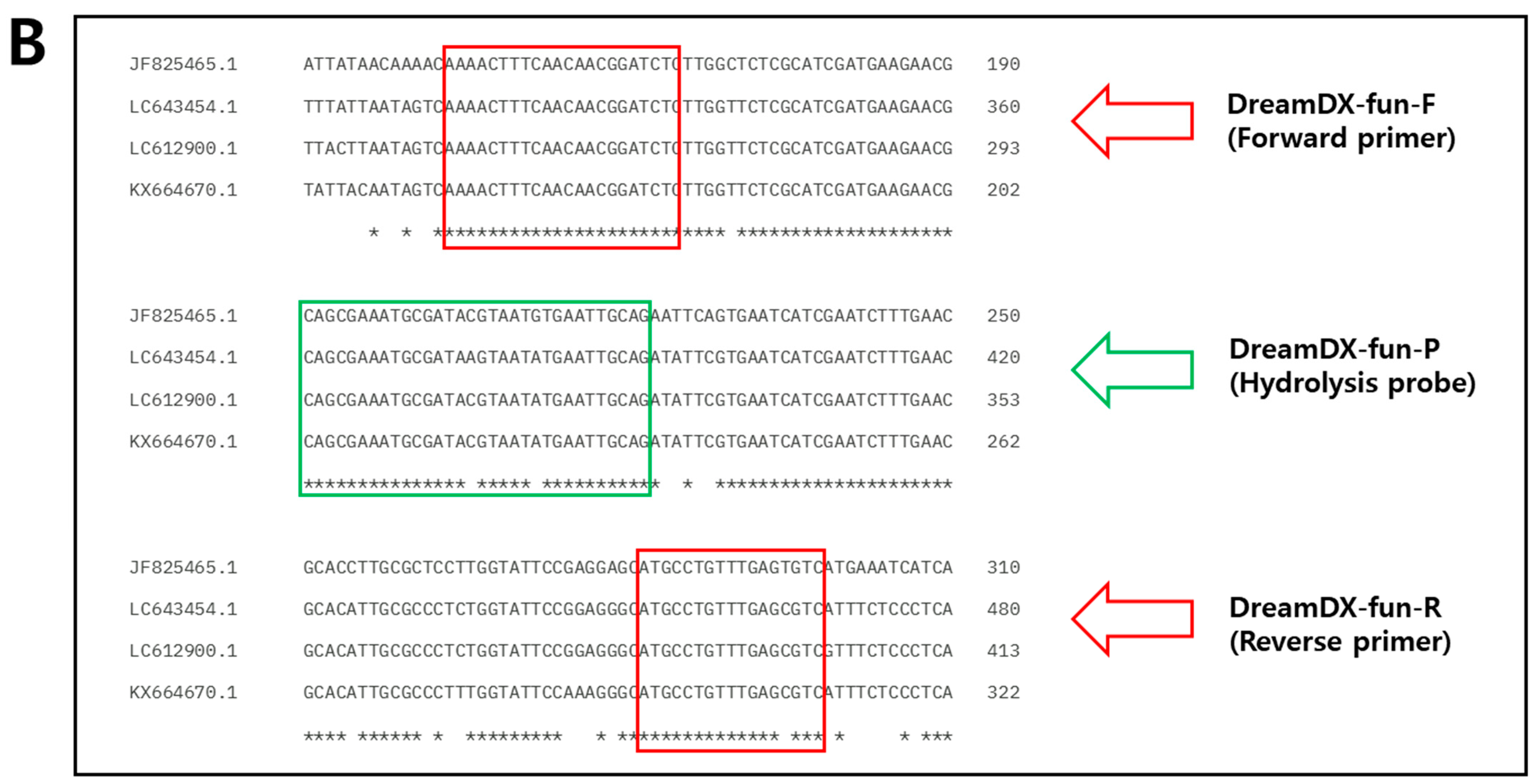


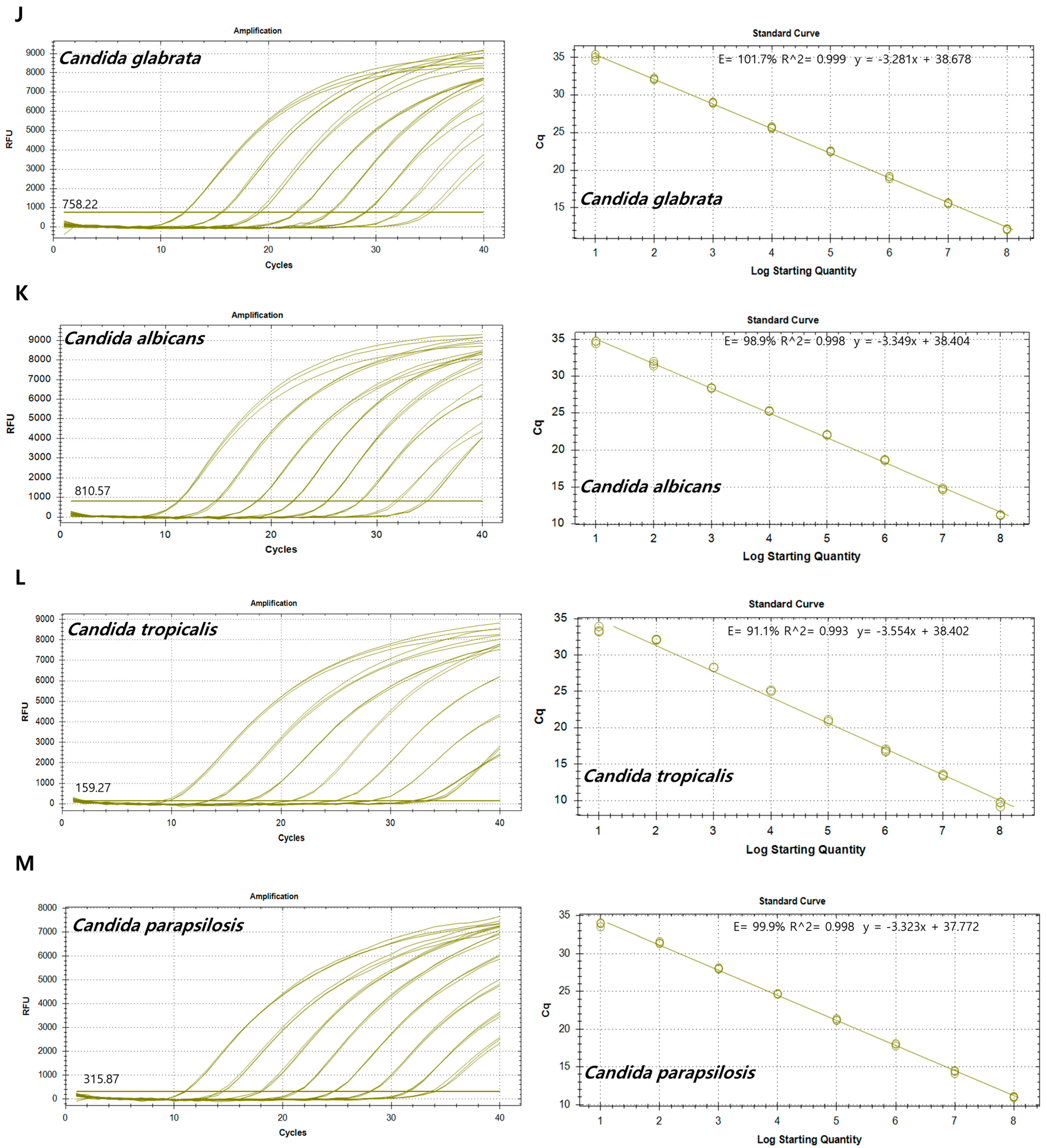
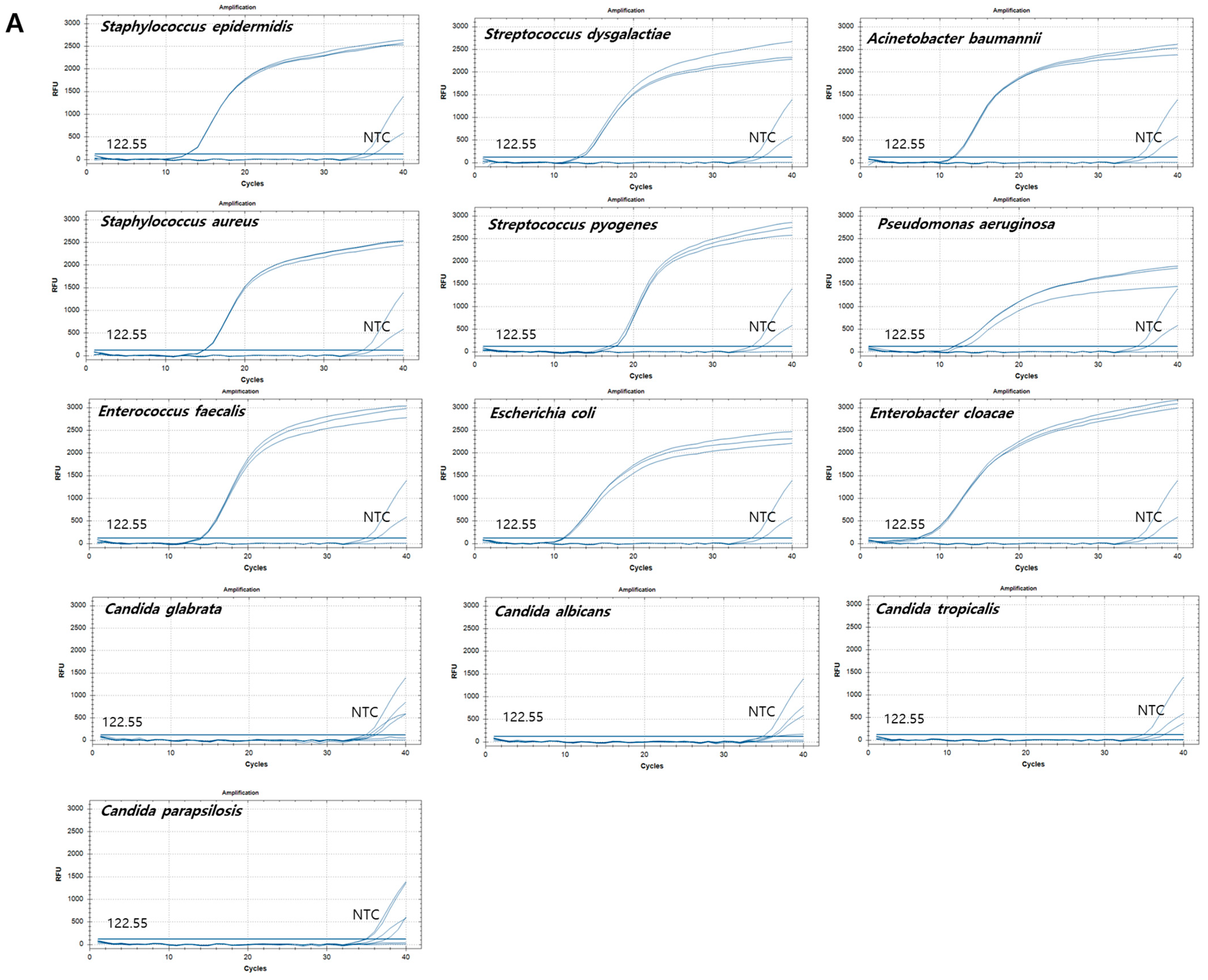

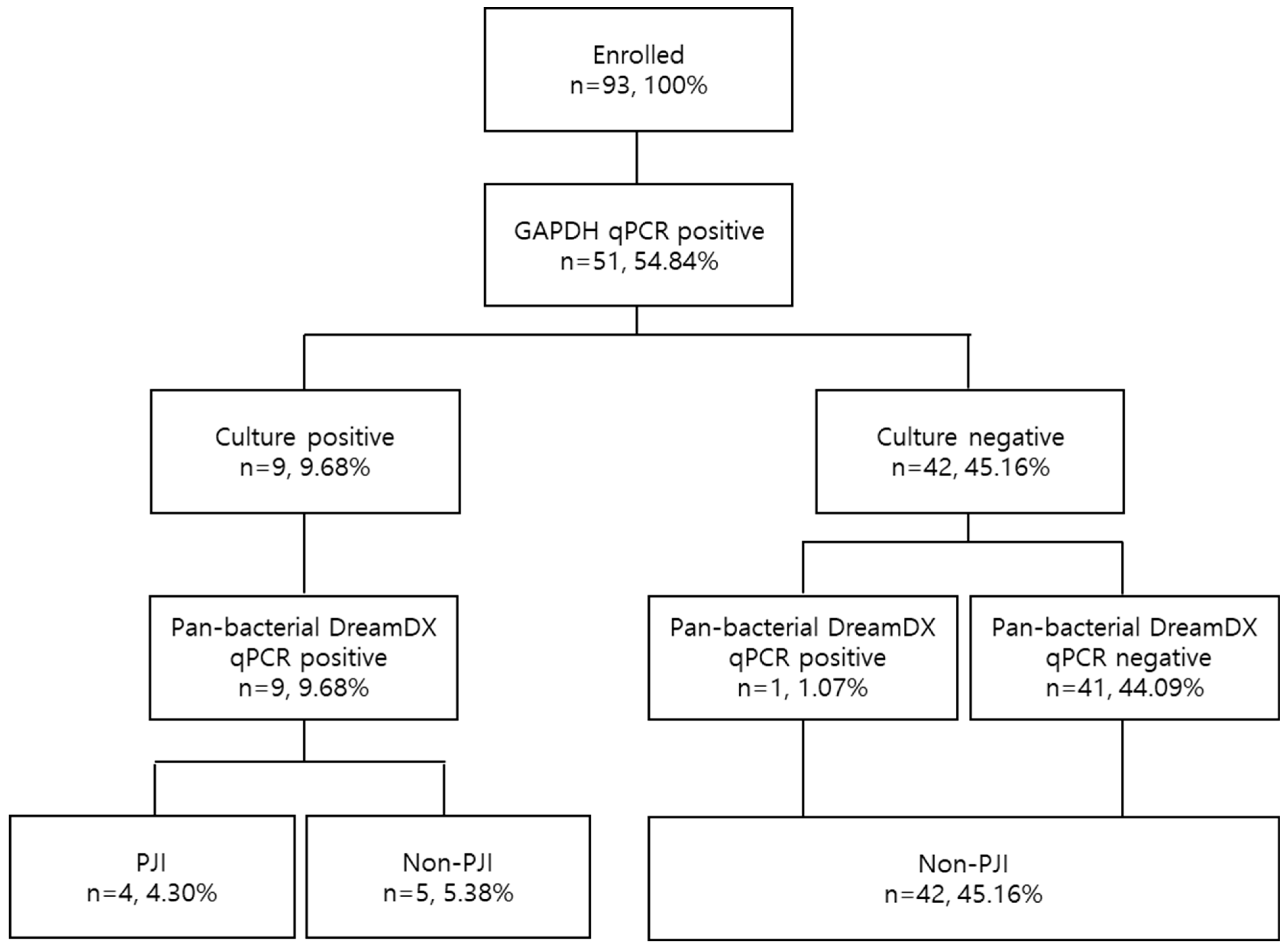

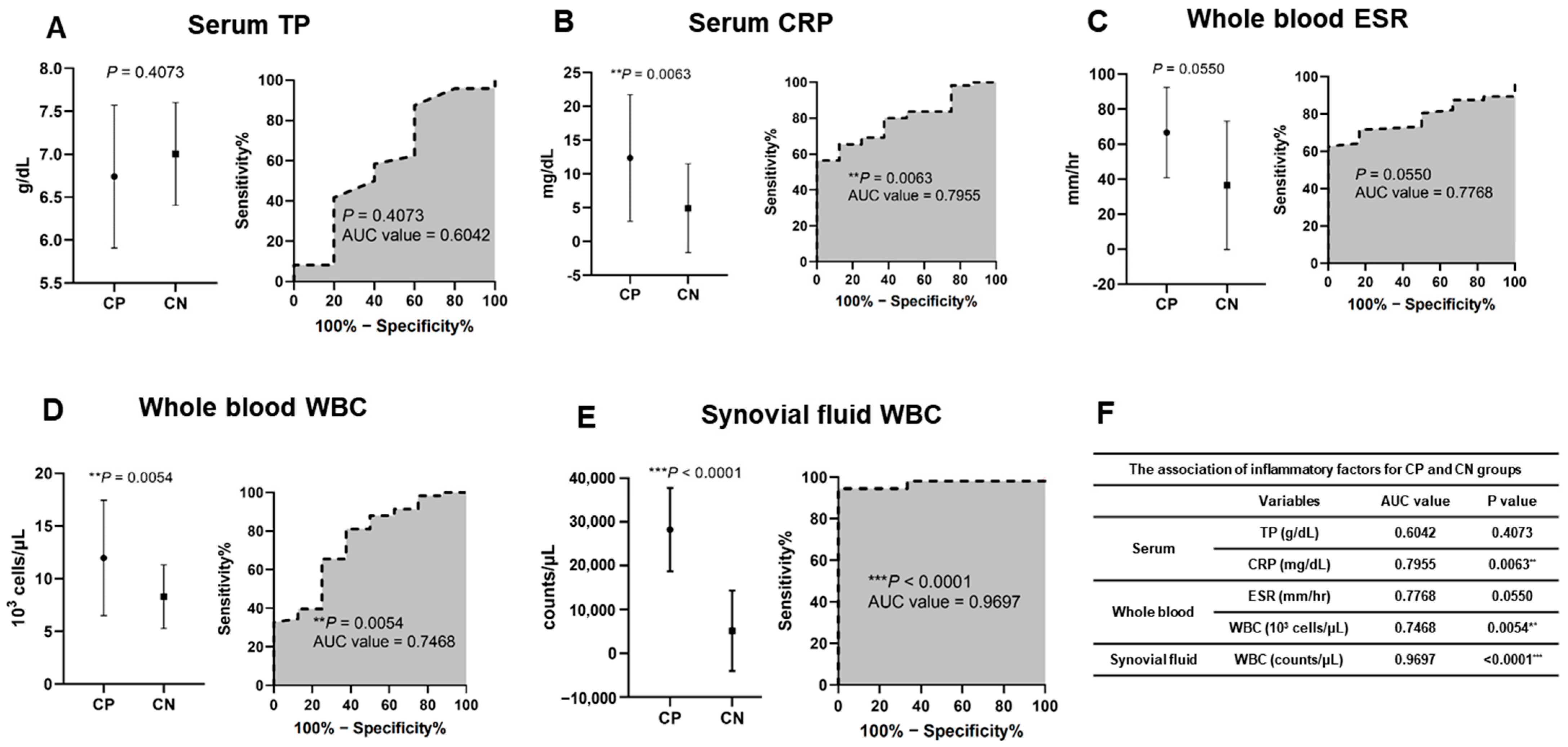
| GAPDH-Positive (Ct < 30) | GAPDH-Negative (Ct ≥ 30) | Total | |
|---|---|---|---|
| Number of SF samples (n, %) | 51 (54.84%) | 42 (45.16%) | 93 (100%) |
| Ct value (mean ± SD) | 21.8 ± 4.28 | 34.2 ± 2.72 | 27.4 ± 7.17 |
| Bacterial CP (n = 9, 100%) | Bacterial CN (n = 84, 100%) | Total Patients and Fungal CN (n = 93, 100%) | ||
|---|---|---|---|---|
| Characteristics | Mokdong Himchan Hospital (n, %) | 8 (88.9%) | 46 (54.8%) | 54 (58.1%) |
| Incheon Himchan Hospital (n, %) | 1 (11.1%) | 38 (45.2%) | 39 (41.9%) | |
| Age (years; mean ± SD) | 67.7 ± 19.18 | 66.9 ± 12.91 | 67.0 ± 13.50 | |
| Female (n, %) | 3 (33.3%) | 44 (52.4%) | 47 (50.5%) | |
| Male (n, %) | 6 (66.7%) | 40 (47.6%) | 46 (49.5%) | |
| OA | Surgically treated group (n, %) | 8 (88.9%) | 40 (47.6%) | 48 (51.6%) |
| Non-surgically treated group (n, %) | 1 (11.1%) | 44 (52.4%) | 45 (48.4%) | |
| Organism | Plasmid of Target Strain | Plasmid DNA Concentration | Ct Value | Log Value | LOD Concentration |
|---|---|---|---|---|---|
| Bacteria | Staphylococcus epidermidis | 2.50 fg/μL | 29.51 | 2.93 | 8.42 × 102 copies/μL |
| Staphylococcus aureus | 2.50 fg/μL | 29.51 | 2.93 | 8.42 × 102 copies/μL | |
| Enterococcus faecalis | 6.00 fg/μL | 29.56 | 2.86 | 7.31 × 102 copies/μL | |
| Streptococcus dysgalactiae | 4.00 fg/μL | 28.54 | 2.96 | 9.19 × 102 copies/μL | |
| Streptococcus pyogenes | 8.00 fg/μL | 29.43 | 2.88 | 7.53 × 102 copies/μL | |
| Escherichia coli | 7.00 fg/μL | 28.61 | 3.01 | 1.03 × 103 copies/μL | |
| Acinetobacter baumannii | 20.0 fg/μL | 28.57 | 3.88 | 7.55 × 103 copies/μL | |
| Pseudomonas aeruginosa | 8.00 fg/μL | 28.56 | 2.96 | 9.19 × 102 copies/μL | |
| Enterobacter cloacae | 7.00 fg/μL | 28.14 | 3.05 | 1.13 × 103 copies/μL | |
| Fungi | Candida glabrata | 9.00 fg/μL | 28.94 | 2.97 | 9.29 × 102 copies/μL |
| Candida albicans | 7.00 fg/μL | 28.36 | 3.00 | 9.98 × 102 copies/μL | |
| Candida tropicalis | 7.00 fg/μL | 28.31 | 2.84 | 6.91 × 102 copies/μL | |
| Candida parapsilosis | 9.00 fg/μL | 27.98 | 8.95 | 8.85 × 102 copies/μL |
| Reference Strain | Sequencing Primer | Accession No. | Description | Maximum Score | Total Score | Query Cover | E Value | Percent Identified |
|---|---|---|---|---|---|---|---|---|
| Staphylococcus epidermidis ATCC 35989 | DreamDX primer | KY442756.1 | Staphylococcus epidermidis strain RmS2T 16S ribosomal RNA gene, partial sequence | 431 | 431 | 41% | 1 × 10−115 | 99.16% |
| Universal primer | LC648288.1 | Staphylococcus epidermidis IRQBAS126 gene for 16S rRNA, partial sequence | 2058 | 2058 | 98% | 0.0 | 99.38% | |
| Staphylococcus aureus ATCC 29213 | DreamDX primer | OQ626118.1 | Staphylococcus aureus strain 344 16S ribosomal RNA gene, partial sequence | 429 | 429 | 50% | 3.00 × 10−115 | 98.37% |
| Universal primer | AP028993.1 | Staphylococcus aureus TUM19959 DNA, complete genome | 113 | 682 | 6% | 9 × 10−20 | 94.52% | |
| Enterococcus faecalis KCTC 3511 | DreamDX primer | MK791584.1 | Enterococcus faecalis strain CE_1_5 16S ribosomal RNA gene, partial sequence | 425 | 425 | 59% | 3 × 10−114 | 97.60% |
| Universal primer | HG799973.1 | Enterococcus faecalis partial 16S rRNA gene, isolate OCAT41 | 1984 | 1984 | 96% | 0.0 | 96.67% | |
| Streptococcus dysgalactiae subsp. equisimilis KCTC 3098 | DreamDX primer | CP053074.1 | Streptococcus dysgalactiae subsp. equisimilis strain TPCH-A88 chromosome, complete genome | 401 | 2411 | 28% | 1 × 10−106 | 96.37% |
| Universal primer | CP053074.1 | Streptococcus dysgalactiae subsp. equisimilis strain TPCH-A88 chromosome, complete genome | 1825 | 10,948 | 99% | 0.0 | 99.70% | |
| Streptococcus pyogenes ATCC 19615 | DreamDX primer | LS483391.1 | Streptococcus pyogenes strain NCTC8320 genome assembly, chromosome: 1 | 442 | 2654 | 10% | 2 × 10−118 | 99.59% |
| Universal primer | HG316453.2 | Streptococcus pyogenes H293, complete genome | 1567 | 9374 | 97% | 0.0 | 96.35% | |
| Escherichia coli O157: H7 ATCC 35150 | DreamDX primer | CP123592.1 | Escherichia coli strain DJH_137 urine chromosome, complete genome | 427 | 2953 | 57% | 1 × 10−114 | 97.98% |
| Universal primer | MT279578.1 | Escherichia coli strain E.Sa.12 16S ribosomal RNA gene, partial sequence | 2050 | 2050 | 95% | 0.0 | 97.36% | |
| Acinetobacter baumannii KCTC 23254 | DreamDX primer | CP096717.1 | Acinetobacter baumannii strain 5741 chromosome, complete genome | 433 | 2571 | 25% | 5 × 10−116 | 98.77% |
| Universal primer | LN611357.1 | Acinetobacter baumannii partial 16S rRNA gene, isolate 4031 | 2043 | 2043 | 97% | 0.0 | 97.20% | |
| Pseudomonas aeruginosa KCTC 22063 | DreamDX primer | MK348744.1 | Pseudomonas aeruginosa strain EC8A23 16S ribosomal RNA gene, partial sequence | 424 | 424 | 6% | 1 × 10−112 | 97.23% |
| Universal primer | HM439417.1 | Pseudomonas aeruginosa strain PCP33 16S ribosomal RNA gene, partial sequence | 226 | 226 | 89% | 9 × 10−54 | 72.19% | |
| Enterobacter cloacae ATCC 2361 | DreamDX primer | CP040827.1 | Enterobacter cloacae strain NH77 chromosome, complete genome | 407 | 3236 | 53% | 1 × 10−108 | 97.90% |
| Universal primer | MN244518.1 | Enterobacter cloacae strain CP21 16S ribosomal RNA gene, partial sequence | 2174 | 2174 | 95% | 0.0 | 98.16% | |
| Candida glabrata KCTC 7219 | DreamDX primer | OP150922.1 | Candida glabrata isolate D2RB internal transcribed spacer 1, partial sequence | 207 | 207 | 23% | 2 × 10−48 | 96.83% |
| Universal primer | ON398731.1 | Candida glabrata isolate UDSMC8_ITS-1 internal transcribed spacer 1, partial sequence | 1537 | 1537 | 67% | 0.0 | 100% | |
| Candida albicans ATCC 10231 | DreamDX primer | KP675137.1 | Candida albicans strain H373A internal transcribed spacer 1, partial sequence | 211 | 211 | 38% | 9 × 10−50 | 99.15% |
| Universal primer | OK267909.1 | Candida albicans clone 13–20 internal transcribed spacer 1, partial sequence | 928 | 928 | 85% | 0.0 | 99.41% | |
| Candida tropicalis KCTC 7212 | DreamDX primer | OP143792.1 | Candida tropicalis isolate D4SDB internal transcribed spacer 1, partial sequence | 211 | 334 | 62% | 8 × 10−50 | 99.15% |
| Universal primer | AB467294.1 | Candida tropicalis gene for ITS1, strain: TL0301 | 817 | 817 | 98% | 0.0 | 96.22% | |
| Candida parapsilosis KCTC 7653 | DreamDX primer | MW703799.1 | Candida parapsilosis isolate IPFUNGSarsCov2-25 small subunit ribosomal RNA gene, partial sequence | 215 | 215 | 64% | 4 × 10−51 | 97.64% |
| Universal primer | MT153735.1 | Candida parapsilosis isolate 4Y137 internal transcribed spacer 1, partial sequence | 887 | 887 | 71% | 0.0 | 99.59% |
| No. | Organism | Quantity of Colonies | Ct Value (Mean ± SD) | Sequencing Primer | Accession No. | Description | Maximum Score | Total Score | Query Cover | E Value | Percent Identification |
|---|---|---|---|---|---|---|---|---|---|---|---|
| 1 | Staphylococcus aureus (Bacteria) | numerous | 26.1 ± 0.03 | DreamDX primer | OQ626099.1 | Staphylococcus aureus strain 266 16S ribosomal RNA gene, partial sequence | 409 | 409 | 11% | 2 × 10−108 | 98.29% |
| Universal primer | MH447063.1 | Staphylococcus aureus strain B0020-03R 16S ribosomal RNA gene, partial sequence | 1306 | 1306 | 88% | 0.0 | 90.72% | ||||
| 2 | Staphylococcus aureus (Bacteria) | numerous | 24.3 ± 0.3 | DreamDX primer | OQ626118.1 | Staphylococcus aureus strain 344 16S ribosomal RNA gene, partial sequence | 412 | 412 | 37% | 4 × 10−110 | 97.15% |
| Universal primer | AP023034.1 | Staphylococcus aureus TPS3156 DNA, complete genome | 320 | 1895 | 24% | 5 × 10−82 | 86.05% | ||||
| 3 | Streptococcus dysgalactiae (Bacteria) | numerous | 17.0 ± 0.11 | DreamDX primer | CP053074.1 | Streptococcus dysgalactiae subsp. equisimilis strain TPCH-A88 chromosome, complete genome | 427 | 2566 | 24% | 2 × 10−114 | 98.36% |
| Universal primer | OP263260.1 | Streptococcus dysgalactiae subsp. equisimilis strain RERA134 16S ribosomal RNA gene, partial sequence | 1903 | 1903 | 92% | 0.0 | 95.29% | ||||
| 4 | Escherichia coli (Bacteria) | moderate | 20.5 ± 1.32 | DreamDX primer | CP088766.1 | Escherichia coli strain B16EC0875 plasmid pB16EC0875-2, complete sequence | 440 | 440 | 25% | 3 × 10−118 | 99.59% |
| Universal primer | KP276714.1 | Escherichia coli strain UT1 16S ribosomal RNA gene, partial sequence | 1122 | 1122 | 51% | 0.0 | 92.69% | ||||
| 5 | Staphylococcus epidermidis (Bacteria) | few | 29.2 ± 0.88 | DreamDX primer | OR740675.1 | Staphylococcus epidermidis strain CM334 16S ribosomal RNA gene, partial sequence | 436 | 436 | 10% | 1 × 10−116 | 99.17% |
| Universal primer | FJ835669.1 | Uncultured bacterium clone YO00379D02 16S ribosomal RNA gene, partial sequence | 479 | 479 | 23% | 8 × 10−130 | 99.25% | ||||
| 6 | Staphylococcus epidermidis (Bacteria) | few | 25.9 ± 0.99 | DreamDX primer | OR740675.1 | Staphylococcus epidermidis strain CM334 16S ribosomal RNA gene, partial sequence | 431 | 431 | 94% | 4 × 10−116 | 98.77% |
| Universal primer | CP043804.1 | Staphylococcus epidermidis strain SESURV_p4_1553 chromosome | 1192 | 7120 | 62% | 0.0 | 95.81% | ||||
| 7 | Serratia marcescens (Bacteria) | moderate | 20.3 ± 0.00 | DreamDX primer | MN493799.1 | Serratia marcescens strain MKBn5e 16S ribosomal RNA gene, partial sequence | 438 | 626 | 50% | 1 × 10−117 | 98.79% |
| Universal primer | OM757735.1 | Serratia marcescens strain SEM 16S ribosomal RNA gene, partial sequence | 1334 | 1334 | 75% | 0.0 | 90.56% | ||||
| 8 | Streptococcus dysgalactiae (Bacteria) | numerous | 17.3 ± 0.10 | DreamDX primer | CP053074.1 | Streptococcus dysgalactiae subsp. equisimilis strain TPCH-A88 chromosome, complete genome | 433 | 2599 | 29% | 4 × 10−116 | 99.17% |
| Universal primer | EF121441.1 | Streptococcus dysgalactiae strain 155719-2 16S ribosomal RNA gene, partial sequence | 1842 | 1842 | 85% | 0.0 | 96.06% | ||||
| 9 | Klebsiella aerogenes (Bacteria) | few | 24.3 ± 2.09 | DreamDX primer | KU308267.1 | Klebsiella aerogenes strain B8 16S ribosomal RNA gene, partial sequence | 438 | 438 | 78% | 3 × 10−118 | 99.18% |
| Universal primer | KT998836.1 | Klebsiella aerogenes strain TIL_WAK_137 16S ribosomal RNA gene, partial sequence | 1247 | 1247 | 68% | 0.0 | 96.24% |
Disclaimer/Publisher’s Note: The statements, opinions and data contained in all publications are solely those of the individual author(s) and contributor(s) and not of MDPI and/or the editor(s). MDPI and/or the editor(s) disclaim responsibility for any injury to people or property resulting from any ideas, methods, instructions or products referred to in the content. |
© 2024 by the authors. Licensee MDPI, Basel, Switzerland. This article is an open access article distributed under the terms and conditions of the Creative Commons Attribution (CC BY) license (https://creativecommons.org/licenses/by/4.0/).
Share and Cite
Lee, J.; Baek, E.; Ahn, H.; Park, H.; Lee, S.; Kim, S. Diagnostic Performance of a Molecular Assay in Synovial Fluid Targeting Dominant Prosthetic Joint Infection Pathogens. Microorganisms 2024, 12, 1234. https://doi.org/10.3390/microorganisms12061234
Lee J, Baek E, Ahn H, Park H, Lee S, Kim S. Diagnostic Performance of a Molecular Assay in Synovial Fluid Targeting Dominant Prosthetic Joint Infection Pathogens. Microorganisms. 2024; 12(6):1234. https://doi.org/10.3390/microorganisms12061234
Chicago/Turabian StyleLee, Jiyoung, Eunyoung Baek, Hyesun Ahn, Heechul Park, Suchan Lee, and Sunghyun Kim. 2024. "Diagnostic Performance of a Molecular Assay in Synovial Fluid Targeting Dominant Prosthetic Joint Infection Pathogens" Microorganisms 12, no. 6: 1234. https://doi.org/10.3390/microorganisms12061234







